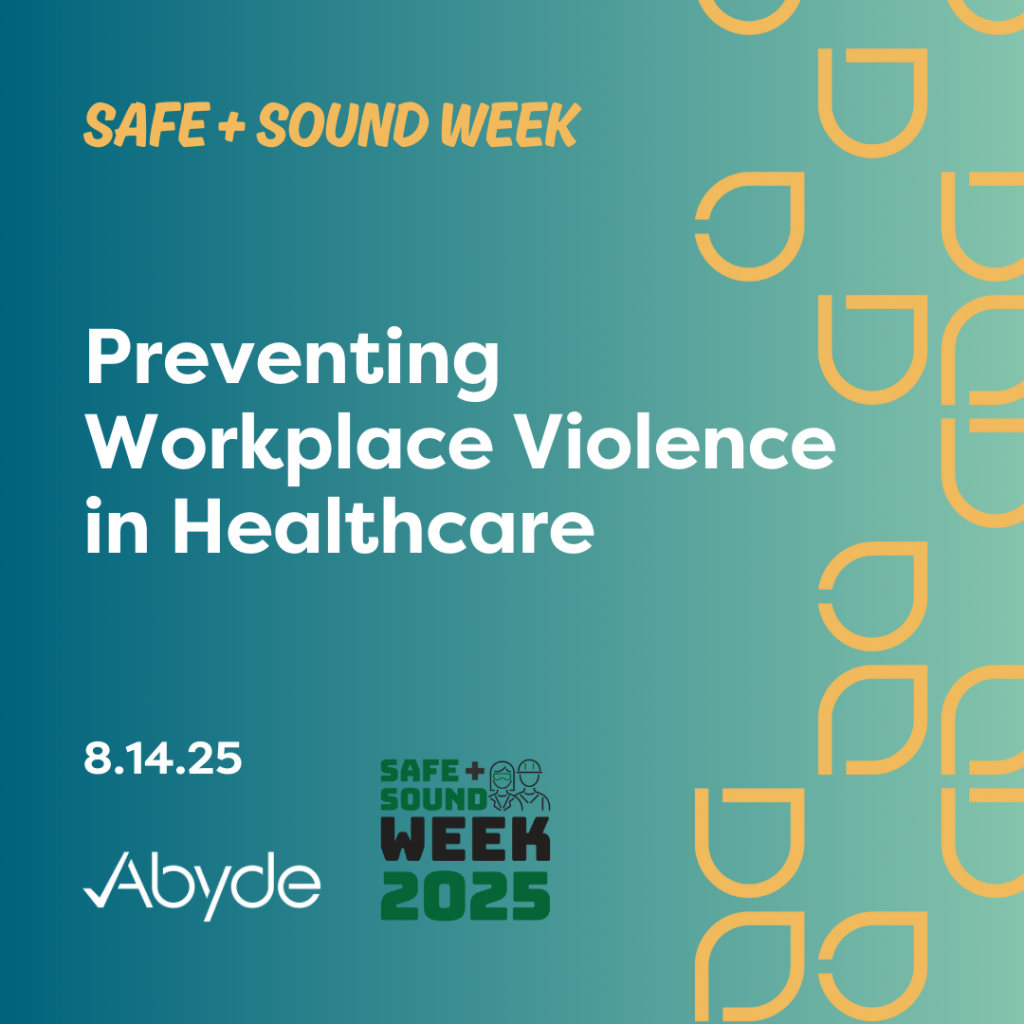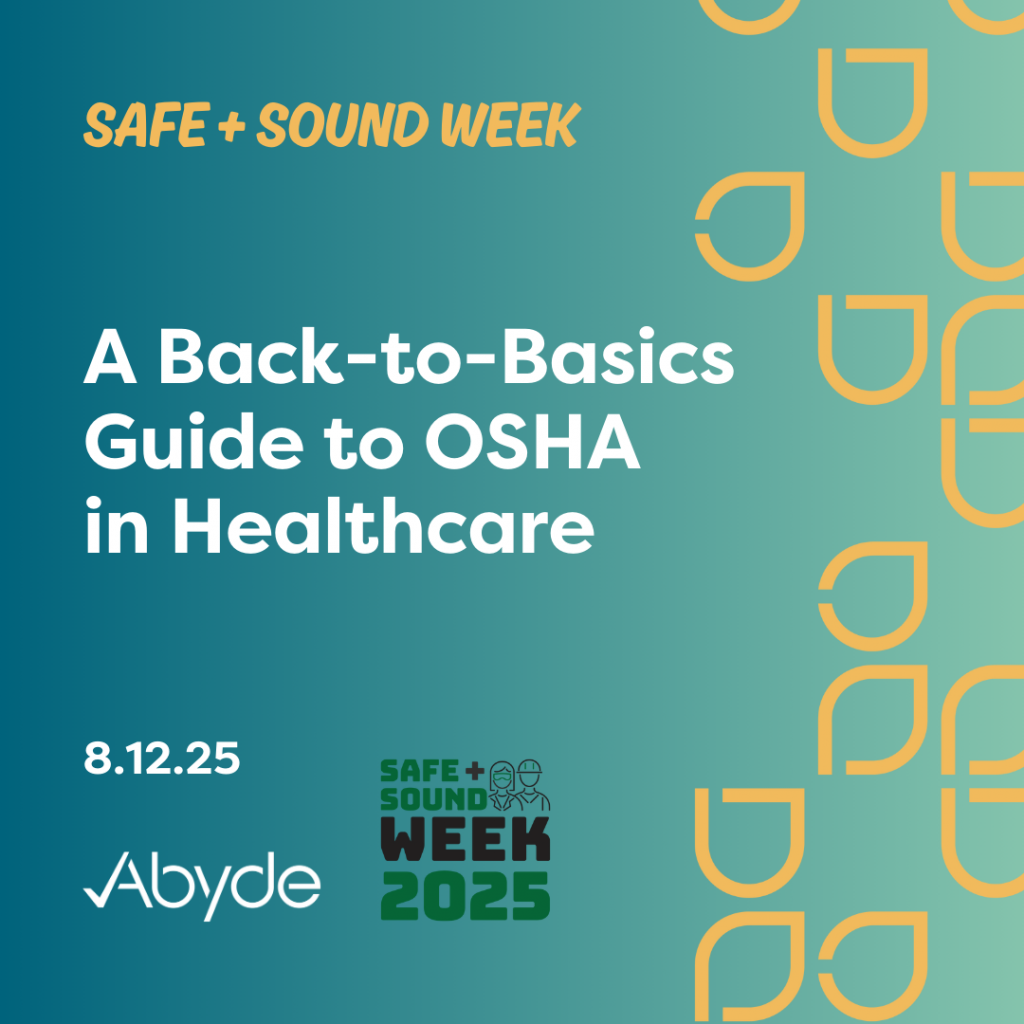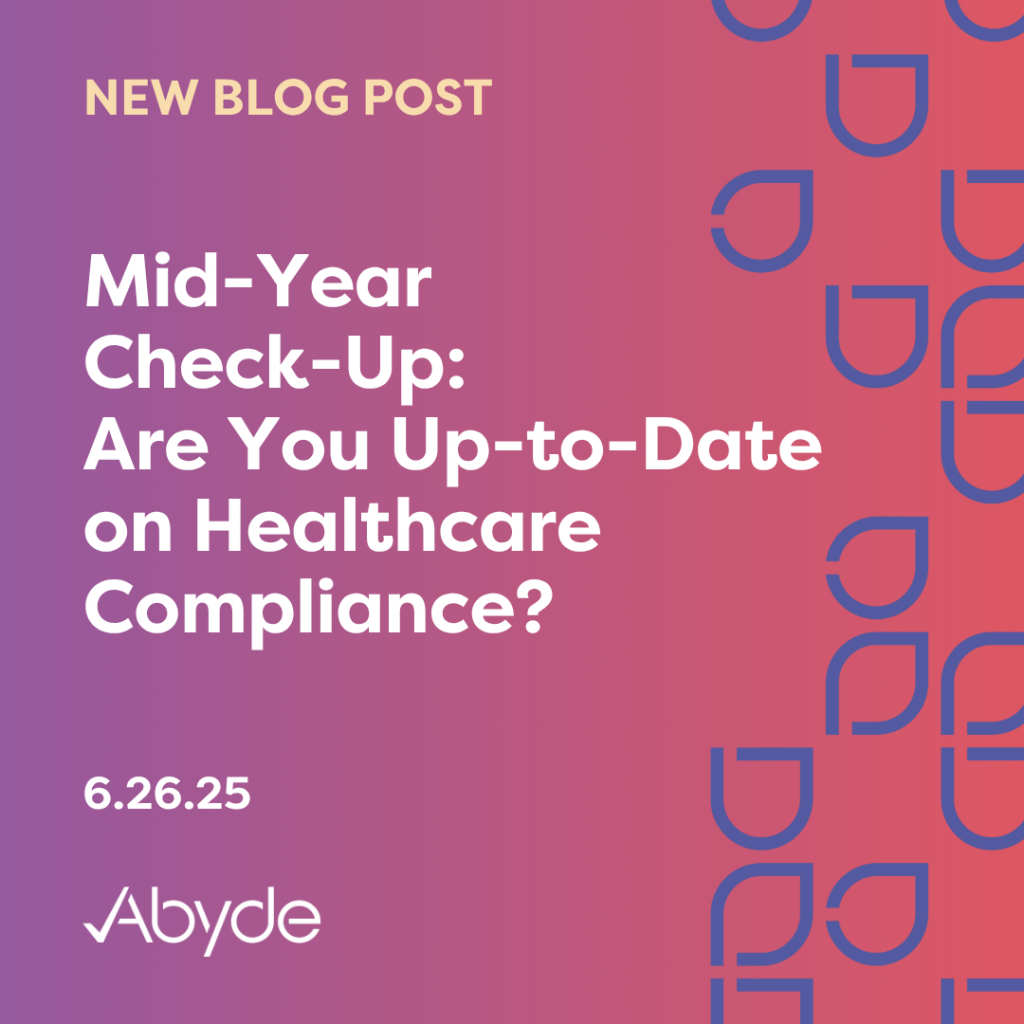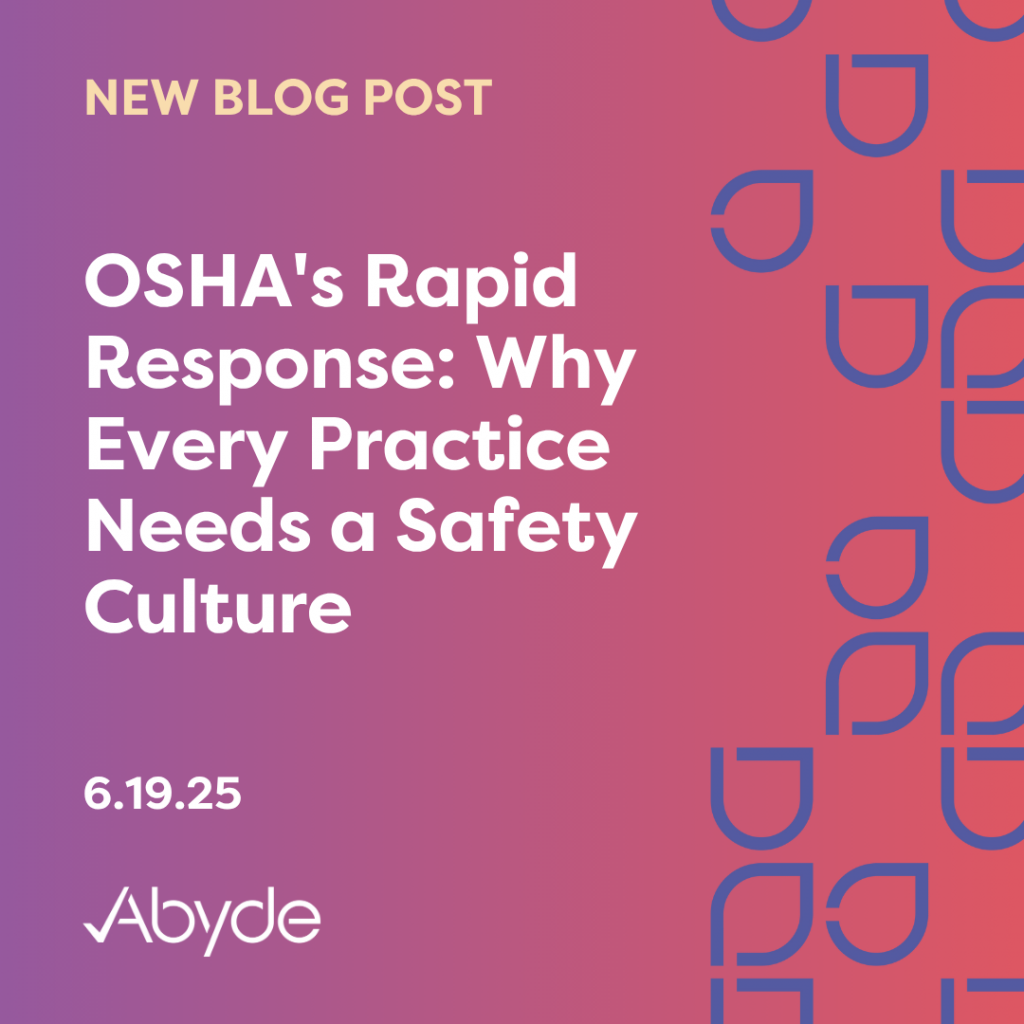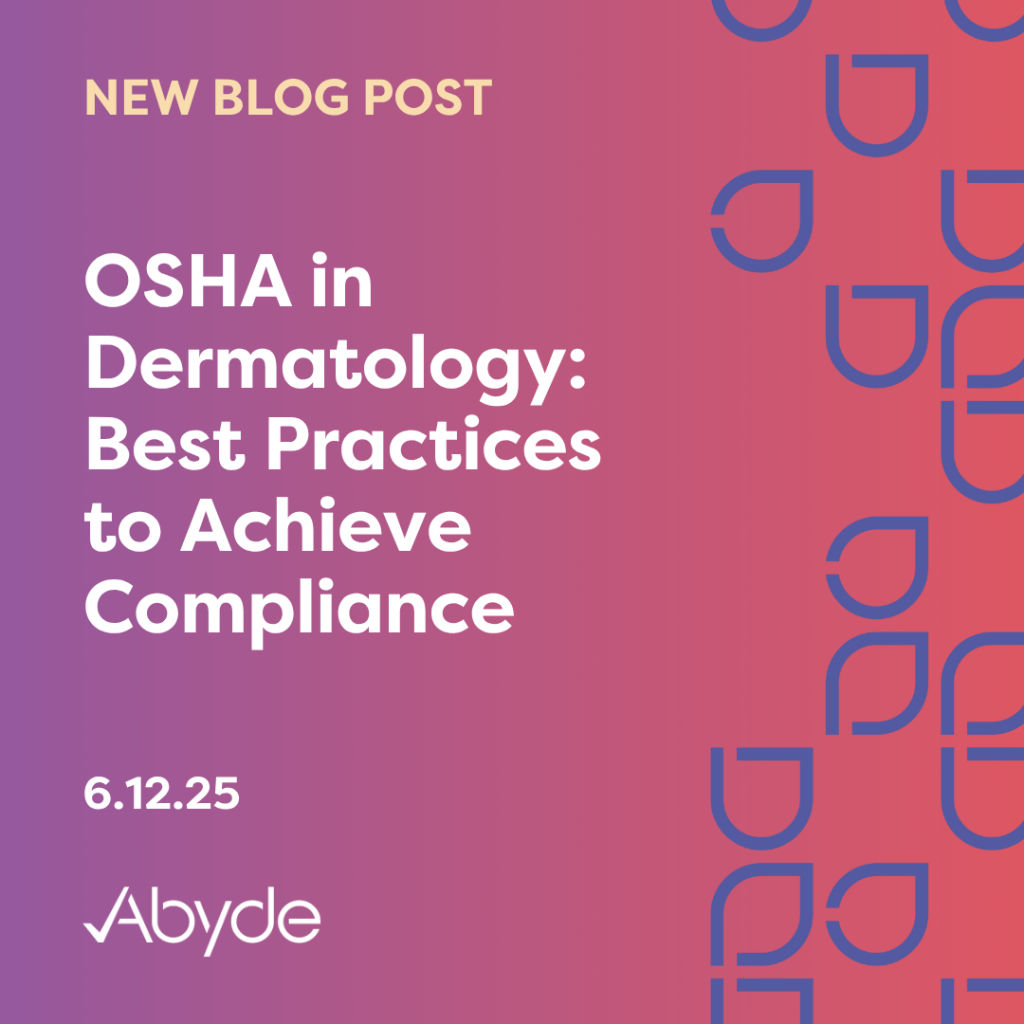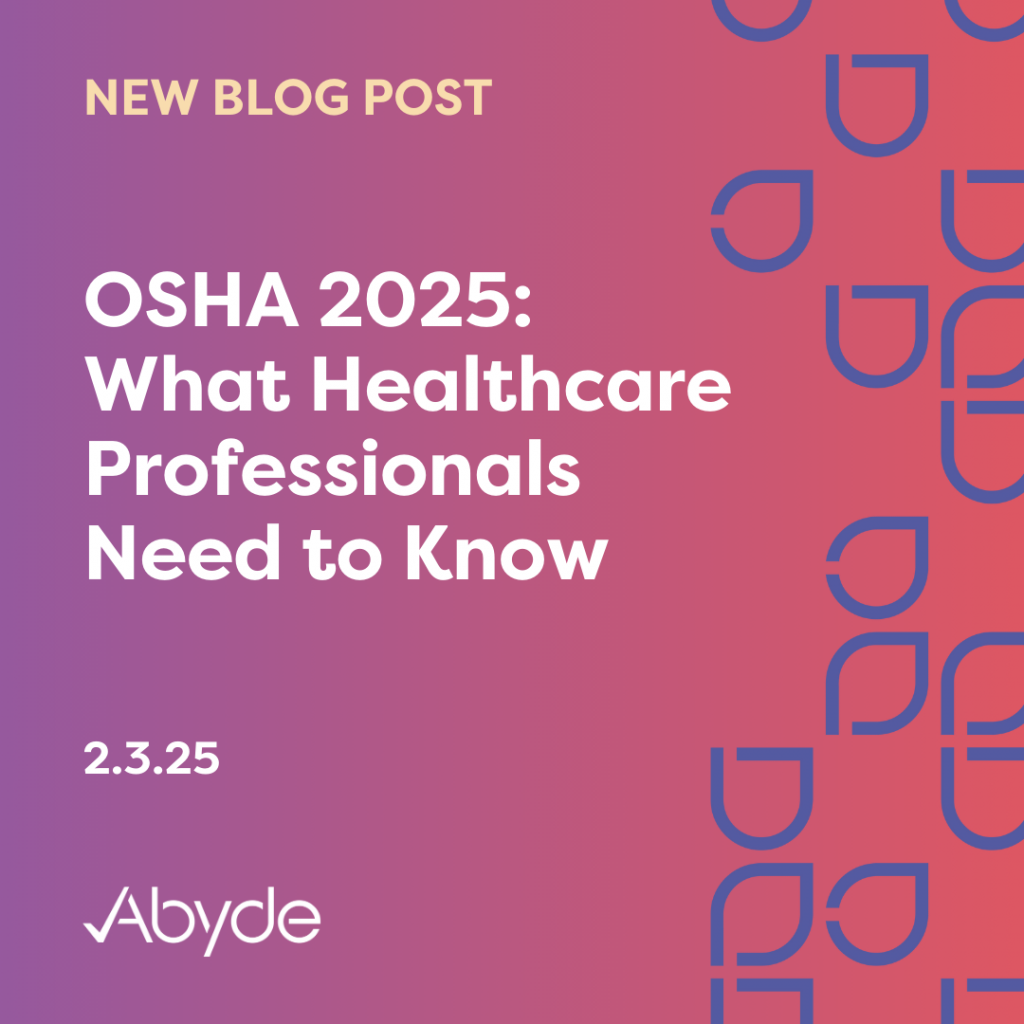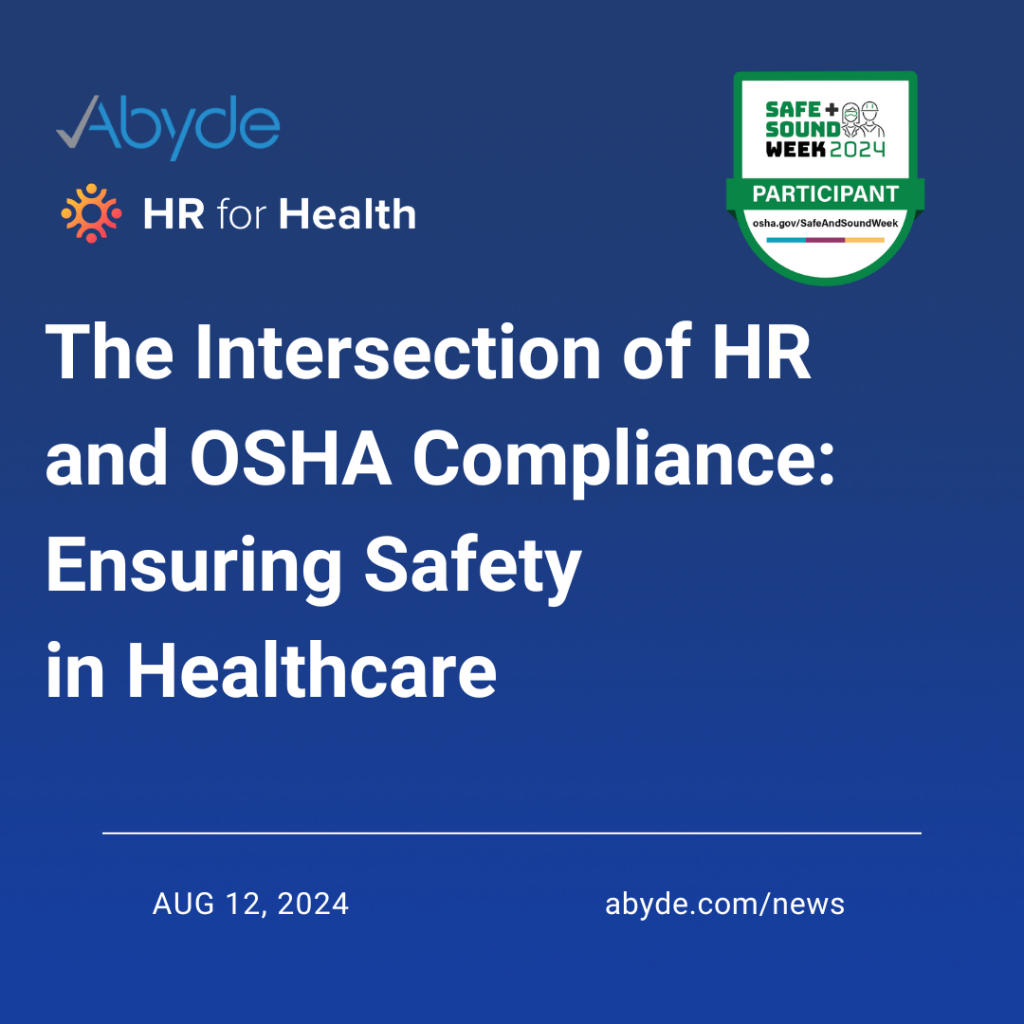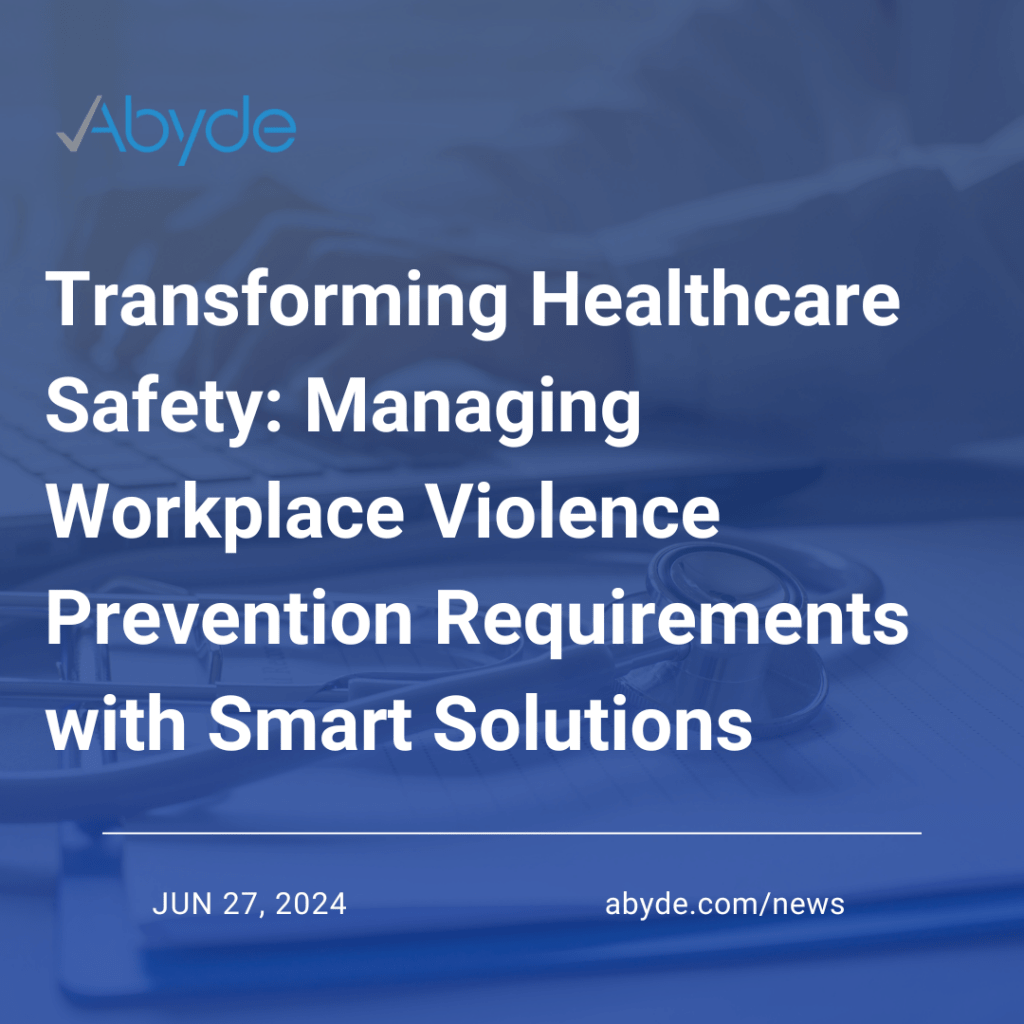November 13, 2025 OSHA doesn’t always call ahead. No heads-up. No appointment. Just, “We’re here. Let’s review your documentation and take a look around.” In fact, half the time OSHA investigates a practice, it’s unannounced. Aside from a random investigation, if anyone in your practice issues a complaint about the work environment or if someone is seriously injured, it’s common for OSHA to conduct an investigation. Take a deep breath! With proactive compliance and an understanding of the investigation process, you can pass with flying colors, keeping your staff safe. What’s an OSHA Investigation? OSHA inspections are routine visits to make sure workplaces are following safety rules. OSHA will target high-risk workplaces, like construction, manufacturing, and, you guessed it, healthcare. When work-related illnesses and injuries in the healthcare industry surpass other fields, it’s no wonder that healthcare is a priority for OSHA. The OSHA official will begin with an opening conference to explain their purpose and the scope of their review. After that, they’ll do a walk-through of your practice and look over your documentation to confirm your safety measures are in place. This can include checking for basics like eye wash stations and accessible fire extinguishers. Your OSHA materials, including risk assessments, SDS library, policies, procedures, and other relevant documents, should be organized and easily accessible to staff. The OSHA investigator can and will also interview staff. Like a pop quiz, your staff must be trained and ready to answer any questions at any time about safety precautions. While being quizzed on OSHA training might not be as fun as being on Jeopardy!, being aware and confident of your practice’s proactive compliance will save your practice from ‘doubling down’ on a massive fine. After a review, a closing conference will be held to review results and next steps. So, what’s after an OSHA Investigation? If everything goes well, hopefully it’s nothing! However, OSHA can and will fine practices found with violations. When the minimum cost of a fine is over a thousand dollars, these violations can quickly add up. In fact, depending on the situation, OSHA fines can cost over $160,000 a violation! Additionally, it can become public record that your practice failed an OSHA audit. OSHA will likely place you on a corrective action plan, ensuring your practice takes the necessary precautions to keep your staff safe. How can I get OSHA Compliant Today? OSHA penalties don’t just sting your budget — they can hurt your reputation, too. But the real reason to stay on top of OSHA isn’t the fine, it’s your people. Protecting your team from preventable injuries and exposures should always come first; avoiding penalties is just the nice side effect. While compliance may feel complicated, it doesn’t have to be that way with the right solution. Smart software can analyze your practice’s compliance standings, offer recommendations, dynamically generate documentation, provide thorough training, and more to ensure your staff is safe every day in your office. Schedule a meeting with a compliance expert to learn more about OSHA compliance in your practice.
Safe + Sound Week: Preventing Workplace Violence in Healthcare
August 14, 2025 While OSHA Safe + Sound Week celebrates workplace safety precautions in your practice, it’s also a time to reflect on shortcomings in the field and how to prevent them. Unfortunately, workplace violence is a prevalent risk in healthcare. Healthcare workers are five times more likely to take time off from work due to workplace violence than those in other fields, so this issue requires attention. While workplace violence currently falls under the General Duty Clause, state-level legislation across the country challenges this. Protecting healthcare workers from violence is possible. By providing your team with the right tools and resources, you can help them mitigate risks and keep everyone safe. What is Workplace Violence? Workplace violence in healthcare is any act or threat intended to harm at the worksite. Several parties can be involved in workplace violence at your practice, including workers, patients/clients, and visitors. In healthcare, workplace violence most frequently occurs when a patient or their family becomes aggressive toward a staff member. Due to the high-pressure environment healthcare can sometimes present, patients can lash out. Even threats are still considered workplace violence. This stress can lead to high levels of staff burnout. How Can I Protect My Staff? The first step to protecting your staff against workplace injuries is cultivating a culture of compliance. This culture ensures that your staff knows the resources provided and feels empowered when navigating difficult situations. Consequently, implementing a zero-tolerance policy on workplace violence is key to protecting your staff. A zero-tolerance policy creates an environment where staff feel supported. Ensure that staff can report workplace violence situations and communicate openly with management. Additionally, your practice must train staff to handle workplace violence situations. Workplace violence prevention training must include the steps for diffusing a problem and how to alert fellow staff. What’s Currently in Place? As mentioned above, workplace violence prevention falls under the General Duty Clause, which requires that all workplaces provide a safe work environment. However, state-level legislation is laying the groundwork for federal legislation. Nearly every state has heightened penalties for assaulting a healthcare worker, making it a felony rather than a misdemeanor. More states continue implementing workplace violence legislation, including comprehensive training requirements. Some states, such as California, require thorough reporting and logs for all workplace violence incidents. Being aware of your state’s specific legislation regarding workplace violence is crucial. Protect Your Staff with Smart Solutions Everyone deserves to feel safe at work. Unfortunately, healthcare workers often experience workplace violence, but this does not have to be their reality. With the right smart solutions, empower your staff this Safe + Sound Week by streamlining OSHA compliance. Intelligent solutions provide thorough, but engaging training for all staff to complete at their own time. Meet with a compliance consultant today to learn more about OSHA compliance in your practice.
Safe & Sound Week: A Back-to-Basics Guide to OSHA in Healthcare
August 12, 2025 Safe + Sound Week celebrates the measures that ensure the safety of your practice staff. But But before you pop the champagne, it’s essential to return to basics. While hard hats, construction sites, and factories often come to mind when thinking of OSHA, healthcare environments are actually among the riskiest workplaces. Ironically, a healing environment can be among the most challenging and hazardous workplaces. Healthcare can present many risks, including exposure to bloodborne pathogens and sharps, respiratory illnesses, upset patients, and more. In a critical field like healthcare, the risks are significant, but so are the rewards. With the right tools, you can protect your staff and maintain high-quality care while avoiding common mistakes that lead to OSHA violations. Sharps Safety We’re sorry if you’re squeamish. Anyone working in healthcare understands the risk of exposure to bloodborne pathogens. From routine dental checkups to the dreaded annual flu shot, healthcare workers encounter many potential OSHA hazards. Fortunately, modern healthcare technology mitigates many of these risks with proper procedures. Most sharps, like needles, are now equipped with self-sheathing technology, minimizing the possibility of injuries. While there are safeguards, needle stick injuries are still prevalent. The World Health Organization states that 3 million healthcare workers worldwide are exposed to bloodborne pathogens annually. Looking to avoid this pitfall? Train your staff and provide the appropriate sharps. Ensure staff know how to use sharps safely, from use to disposal. Your practice should also provide a secure trash can to dispose of sharps and partner with an OSHA-compliant healthcare waste organization to remove and dispose of used sharps. If a healthcare staff member is pricked by a sharp? Provide immediate first aid and have them undergo blood tests to ensure their safety. When it comes to bloodborne pathogens, time is of the essence; quick action can prevent further issues. Personal Protective Equipment (PPE): Not just a Fashion Trend Healthcare professionals are three times more likely to contract respiratory illnesses than those in other industries. While it seems like an unavoidable part of the job, proper use of PPE minimizes these risks. The most effective way to ensure staff are protected is by providing comprehensive training on the correct use of PPE. This training should cover when and how to wear various equipment, from masks and gloves to gowns and face shields. To eliminate any barriers to use, your practice must provide all necessary PPE to staff at no charge. Wearing the correct PPE provides critical protection for your staff, safeguarding them from infectious respiratory pathogens. PPE protects your employees’ health and helps prevent the spread of illness to other patients and colleagues, creating a safer environment for everyone. Navigating Conflict, Ensuring Security Another common OSHA violation in healthcare is, unfortunately, workplace violence. Healthcare workers are five times more likely to experience workplace violence than other workers. The good news is that this issue is finally getting serious attention. This issue has received attention at the state level, with most states increasing penalties for attacks against healthcare workers and implementing additional logs, training, and safety measures. Although this still falls under OSHA’s General Duty Clause, a federal law addressing this issue has been in development for years and is likely to be announced by the end of this year. To keep staff safe, train your team and empower them to report workplace violence. Ensure staff know the procedures for handling an unruly patient or visitor, and follow up after any incident. It is unfortunate that this occurs, but by supporting your staff, you can minimize risks and create a safer workplace. Keep Your Staff Safe and Sound Remember, a strong culture of compliance, rooted in empowerment and education, is the foundation for any successful practice. You can significantly reduce risks and avoid costly violations by proactively training your team, providing the right tools, and empowering them to speak up. Smart solutions can streamline training, policies, procedures, and more, ensuring all staff know the safeguards to protect them at work. A safe practice is a strong one, and it will thrive, allowing your team to continue providing your patients the highest quality of care. Meet with a compliance expert today to learn more about OSHA in your practice.
Mid-Year Check-Up: Are You Up-to-Date on Healthcare Compliance?
June 26, 2025 Healthcare compliance is an ever-evolving landscape, with new initiatives and updates announced to better protect patients and staff. As the year progresses to its midpoint, it’s crucial to seize this opportunity to stay informed on the latest developments in the field. HIPAA and OSHA both have new significant updates that will directly impact practices. New HIPAA Security Rule Legislation In December 2024, the Office for Civil Rights (OCR) released proposed updates to the HIPAA Security Rule. One of the pillars of the Health Information Portability and Accountability Act, the Security Rule focuses on the safeguards that must be deployed to keep Protected Health Information (PHI) secure. In response to the rise of large breach ransomware attacks, which have nearly tripled in the last several years, the OCR is increasing cybersecurity requirements when handling patient PHI. For instance, under this new legislation, some new requirements include an asset log, network segmentation, and multi-factor authentication. These requirements are all heightened precautions when protecting patient data. Under this new legislation, the vendors your practice works with will also experience increased scrutiny. For example, under this proposed rule, Business Associates (BAs) now must have their compliance practices verified by a cybersecurity expert annually. BAs must also alert Covered Entities within 24 hours after a breach with a contingency plan. These soon-to-be added responsibilities demonstrate the vital role BAs play in protecting patients. The comment period for these updates wrapped up in March, and the OCR is reviewing all 4,000 comments before a final rule is announced. Workplace Violence Prevention Legislation When healthcare workers are five times as likely to experience workplace violence, federal legislation is soon to follow. While Workplace Violence Prevention currently falls under the General Duty Clause of OSHA, or the basic requirement of providing a safe workplace for employees, state-level legislation focused on this continues to go into effect. State legislation regarding this vastly differs. Nearly every state has heightened charges for attacking a healthcare worker, being classified as a felony rather than a misdemeanor. Still, now many are requiring specialized training and reporting requirements specifically addressing violence in healthcare workplaces. For example, California, Texas, and Virginia all have comprehensive healthcare workplace violence plans. California even requires near misses and threats to be logged for the state. While federal legislation has not been released yet, a Notice of Proposed Rulemaking (NPRM) will likely be announced this year. HIPAA Audit Program & Risk Analysis Initiative The OCR has reintroduced the HIPAA Audit Program, randomly selecting HIPAA-regulated entities and reviewing their current HIPAA programs. The last time this program was in effect was in 2017. The last round of audits found that 86% of Covered Entities could not produce a compliant Security Risk Analysis (SRA) when prompted by the OCR. The SRA is a thorough assessment of the safeguards and routines currently in place to secure PHI. Practices frequently overlook the Security Risk Analysis (SRA), yet it’s a primary defense, proactively addressing concerns. In fact, the OCR’s October 2024 Risk Analysis Initiative specifically targets practices that fail to complete an SRA, and this initiative has already resulted in nearly a million dollars in fines. Right of Access Fines Improper patient records release continue to be a common pitfall for practices. Records must be provided to patients within 30 days of a request. With over 50 enforcements of the Right of Access Initiative, millions of dollars have been paid by practices. This easily preventable fine highlights the significant impact of patient complaints (the leading cause for investigations) and the OCR’s diligence in addressing Right of Access violations. Getting Prepared for the Rest of the Year While it feels like new initiatives are frequently being announced by the OCR, it is your practice’s responsibility to implement new updates. With the right HIPAA compliance program, smart software can ensure your practice will always be prepared, with new legislation instantly updating in the software. To learn more about what’s next in HIPAA, watch our latest webinar regarding current events in HIPAA here.
OSHA’s Rapid Response: Why Every Practice Needs a Safety Culture
June 19, 2025 The success of your practice hinges on the safety of your staff. When staff feel unsafe, OSHA quickly demonstrates its commitment to staff protection. A recent healthcare OSHA fine highlights how efficiently OSHA complaints are handled. Opulent Pediatrics faced expedited penalties following a staff complaint, just months after the initial complaint. From the case opening in March to its resolution in June, OSHA underscored the severity and importance it places on staff complaints. Complaints are also the most common way HIPAA investigations are initiated. This rapid response showcases the need for practices to provide a safe work environment and foster a culture of compliance, empowering staff members to communicate needs and concerns. What Happened? In March 2025, a staff member of Opulent Pediatrics sent a formal complaint to OSHA due to unsafe working conditions. The Roanoke regional office investigated the pediatric practice unannounced, not providing time for the practice to address any concerns. Following their investigation, it was discovered that the practice violated several safety requirements, such as bloodborne pathogen safety, improper medical services, or missing first aid unavailable to staff, improper handling of wiring and equipment, and insufficient hazard communication documentation. After the investigation, by April, OSHA noted seven citations and issued an initial penalty of over $14,000. It’s inferred that the practice was willing and cooperative, with the final fine totalling over $2,000 by the abatement date in May. Protecting Staff in Healthcare While Opulent Pediatrics dodged a more significant fine, this enforcement action demonstrates OSHA’s swift investigative response to complaints. From the initial investigation to its conclusion, the case only took three months. OSHA can and will investigate without notice, so ensure your OSHA program documentation is readily available. With the right tools, ensuring staff safety can be simplified. In this case, training and proper documentation could have avoided these fines. Consider how an intelligent OSHA software solution centralizes training, such as for bloodborne pathogens, hazard communication, and all other OSHA documentation, making it easily accessible to every staff member within a compliance hub. Moreover, by prioritizing safety in your practice, staff can feel empowered to communicate concerns. To learn more about streamlining OSHA compliance in your healthcare practice, schedule a consultation with an expert today.
OSHA in Dermatology: Best Practices to Achieve Compliance
June 12, 2025 While working in a dermatology office might have you focused on taking care of your patients’ skin, your health should be the first priority. It’s easy to incorrectly assume a dermatology office is a relatively “safe” healthcare environment. After all, we’re not typically dealing with the same acute emergencies as an ER. Dermatology presents many challenges when working with patients, such as lasers, sharp instruments, chemicals, potential exposure to bloodborne pathogens, and more. With these unique challenges, your practice must be aware of the safeguards the Occupational Safety and Health Administration (OSHA) requires. More than Skin Deep: Facility Risk Assessment An annual Facility Risk Assessment (FRA) is the foundation of your OSHA compliance program. The FRA is a thorough assessment of the healthcare hazards your practice might face. This assessment spans from your staff is trained, to unique equipment you might use, how situations are prevented, and even how management handles workplace safety. Since this is an annual requirement, this assessment must be kept current. If your practice introduces anything new that might heighten risk, this needs to be documented. For instance, if your practice begins offering laser treatments, this must be mentioned in the FRA and also staff must be trained on how to use it safely. By reviewing and addressing potential vulnerabilities in your practice, you can mitigate risks and ultimately keep patients safe. Personal Protective Equipment (PPE) in Dermatology: Your First Line of Defense While you advise patients on sun protection, remember that your staff’s skin needs protection, too. Always ensure that it remains covered with Personal Protective Equipment (PPE). PPE, like gloves and masks, are essential barriers that keep your team safe. Your practice must supply this PPE and provide comprehensive training on how to use it correctly. For instance, when a staff member is with a patient, a new set of gloves is always required. From putting them on to how they must be disposed of, these are all critical ways to keep staff members safe. Depending on the treatment, your staff may also need eye protection. As a result, it’s essential to review all available forms of PPE with staff before they start working with patients. Dermatology Laser Safety When it comes to lasers in your dermatology practice, preparation is paramount. It’s not enough to just have the equipment; you need to ensure every team member is properly trained and fully aware of the risks associated with these powerful devices. Once again, proper PPE is vital, such as eyewear and gloves. Additionally, the room where the laser is being used must adhere to safety guidelines, including not having any reflective surfaces for the laser to shine off. Your practice should designate a Laser Safety Officer to oversee and enforce compliance. This staff member is likely already your OSHA Safety Officer, or OSO. This Laser Safety Officer needs to ensure staff is routinely trained on lasers, especially if new equipment is being used. For staff safety, the laser device must be off when not in use. While laser treatments offer dermatologists innovative possibilities, proper staff training always remains crucial. Keeping Your Dermatology Practice Safe Ensuring the safety of your dermatology practice is not just about compliance; it’s about fostering a secure environment for both your dedicated staff and your valued patients. Your practice can proactively address potential hazards by diligently conducting annual facility risk assessments, consistently utilizing appropriate personal protective equipment, and prioritizing comprehensive training. With the right solution, your practice can streamline these requirements. Smart software can utilize the answers from your FRA and provide thorough policies and procedures and recommended training. A safe practice is a successful practice. To see how you can streamline compliance for your practice, schedule a meeting with a compliance expert today.
A Dentist’s Guide to OSHA Compliance
May 15, 2025 On a global scale, more than 2 million healthcare workers experience needle-stick injuries on an annual basis. Dentists are at the most at risk, with 59% of dentists studied experiencing needle stick injuries. Dentists are particularly susceptible to OSHA violations due to the daily use of sharps and the increased possible exposure to bloodborne pathogens and saliva when working in patients’ mouths. Protecting your dental team through safety and compliance isn’t just a good idea—it’s essential. Here’s a clear look at the standard preventive measures for OSHA in dentistry. First Line of Defense: Training There are numerous safety precautions to keep staff safe, but the first layer of protection is proper training and procedures. Before working with patients, staff must be thoroughly trained on the possible risks and mitigation techniques. Staff must also be provided a walk-through of the practice, assuring they know where all emergency equipment and exits are located. Training programs must review all possible risks, like sharps, bloodborne pathogens, radiation, etc. Videos and training materials must be easily accessible for staff to review. All relevant policies outlining compliant procedures for various situations must also be accessible to all staff members. Training is the foundation of a compliant practice, and with proper OSHA in dentistry training, your staff can feel confident handling any situation. Always Wear Personal Protective Equipment While it might not always be the most fashionable decision, wearing Personal Protective Equipment (PPE) is imperative to keep staff safe. It is key that staff always wear PPE when working with patients. PPE can be defined as gloves, masks, gowns, face shields, and more. By wearing PPE, your staff have a barrier when working with patients, minimizing the risks of exposure. PPE must be provided to staff free of charge, cultivating a safe environment. Staff must also be appropriately trained to use PPE when working with patients, ensuring all know the necessary steps to protect themselves. PPE minimizes exposure to risks by limiting contact with patients, and is a staple for a safe healthcare practice. Stay Sharp: Handling Needles Carefully Dentists are well aware of the risks associated with working with needles, scalers, and other sharps. Use sharps carefully and utilize devices with safety features when working with sharps. Many sharps have preventative measures, like retractable needles after use, self-sheathing blades, and reinforced containers for sharps. When using sharps, ensure your staff wear gloves and other applicable PPE. Sharps handling, from initial use on a patient to disposal, requires strict adherence to safety protocols to minimize the risk of accidental sticks and the transmission of bloodborne pathogens. Bloodborne Pathogens 101 Working in healthcare, especially dentistry, puts staff at risk for exposure to bloodborne pathogens. Bloodborne pathogens are microorganisms that cause disease, like hepatitis B, C, and HIV. The World Health Organization states that 3 million healthcare workers are exposed to bloodborne diseases through skin puncture injuries each year. With PPE and appropriate sharps equipment, your staff is already significantly mitigating risk. However, if a sharp needle or blade pricks a staff member, it is essential to receive First Aid to protect the wound immediately. The staff member should have their blood tested as soon as possible. Depending on the situation, time is of the essence after a sharps incident. Some diseases, like HIV, can be prevented within 3 days of exposure. While it can be overwhelming, staff must stay calm and follow the proper procedures after an incident, with most sharps incidents not resulting in an infection. Simplifying OSHA Compliance As you can see, handling OSHA compliance in dentistry can be daunting. With the correct compliance program to address numerous risks, your dental staff can feel secure and concentrate on delivering excellent patient care. Intelligent OSHA software offers automatically generated policies, required forms, and training resources in a centralized compliance hub, providing a documented compliance program for your team. Meet with a compliance expert today to learn more about how you can streamline your OSHA compliance program.
OSHA 2025: What Healthcare Professionals Need to Know
February 3, 2025 We’ve already seen that 2025 will be a year of major healthcare compliance changes, with the OCR releasing the long-awaited updates to the Security Rule proposal. Similar to how HIPAA laws are being updated, OSHA will likely update key legislation for healthcare workers. Healthcare workers experience the highest rates of workplace injuries, with an average of 3.6 injuries for every 100 employees. Healthcare environments can present many hazards, so it is essential that your staff knows how to prevent and mitigate dangerous situations. While some OSHA initiatives have not been finalized, OSHA has already started the year with legislation that impacts healthcare workers. Increased Penalty Costs As seen in previous years, OSHA has once again increased its fine cost. OSHA has increased the penalty for serious and other-than-serious violations from $16,131 to $16,550 per violation due to inflation. The maximum penalty for repeated and willful violations also has been increased from $161,323 to $165,514 per violation. This highlights that OSHA is dedicated to setting an example with monetary punishment. It’s safe to say that this adjustment will continue to be an annual increase. Consolidating COVID-19 Regulations It’s an understatement to say that COVID-19 devastated and transformed healthcare. Nearly five years since it was classified as a pandemic, proposed healthcare OSHA COVID-19 regulations were officially scrapped as of early January. Over the past years, COVID-19 regulations have been altered. Emergency Temporary Standards required distinctive protocols to follow, which expired. A proposed rule for COVID-19 mitigation in healthcare settings was waiting to be passed for years. Now, specific OSHA COVID-19 legislation in healthcare will be rolled into a broader infectious disease rule, which is expected to be finalized in 2025. This comprehensive rule is expected to require COVID-19 recordkeeping log, but not much else focused on specifically COVID-19. The anticipated comprehensive rule will likely mandate a COVID-19 recordkeeping log. Federal Workplace Violence Legislation Healthcare workers are five times more likely to be attacked at work than workers in any other industry. We’ve seen state-level legislation announced requiring specific logs, training, heightened penalties, and more to mitigate workplace violence in healthcare, but federal legislation is still being drafted. Currently, workplace violence falls under OSHA’s General Duty Clause, requiring organizations to maintain “a place of employment which are free from recognized hazards.” This federal legislation is expected to be announced in 2025. It will likely mirror what state legislation requires, so please review your state’s legislation regarding workplace violence prevention in your practice. What’s Next? As new legislation is announced, it’s vital for your practice to maintain an organized OSHA program. New laws, especially focused on workplace violence prevention, will require additional training, logs, and more. Turning to smart software can allow for your practice to simplify and streamline compliance. Cloud-based software automatically updates with the latest legislation, providing your practice with a clear path to compliance. To learn more about how your practice can achieve OSHA compliance, meet with our experts today.
The Intersection of HR and OSHA Compliance: Ensuring Safety in Healthcare
August 12, 2024 This was contributed by HR for Health for OSHA’s Safe + Sound Week At HR for Health, OSHA compliance is a frequent and critical topic of discussion with our clients. As an HR company focused on supporting independent healthcare practices, we understand the importance of taking compliance, training, documentation, and safety seriously. Whether your practice is large or small, adhering to OSHA standards is not just about following the rules—it’s about protecting your employees and fostering a safe work environment that benefits everyone. Compliance laws can seem overwhelming, but it’s a non-negotiable part of running a healthcare practice. Non-compliance can lead to significant penalties, not to mention the time-consuming and expensive lawsuits that could arise if an employee or patient is injured. Beyond the financial implications, a commitment to safety and compliance contributes to a healthier, more productive workplace. But how do you ensure your practice stays compliant without getting bogged down in administrative tasks? That’s where HR for Health and Abyde come in. Together, we provide a comprehensive solution that simplifies the complex worlds of OSHA and employment law compliance, making it manageable for practices of all sizes. Why OSHA Compliance Matters OSHA (Occupational Safety and Health Administration) compliance is about more than just avoiding fines. It’s about creating a workplace where your employees feel safe and supported, which in turn leads to better patient care. Compliance involves familiarizing yourself with OSHA regulations, training your employees, and maintaining accurate records of any incidents or hazards. At HR for Health, we see firsthand how often OSHA compliance comes up in our conversations with clients. It’s a constant concern, and rightly so—OSHA compliance isn’t a one-time effort but an ongoing process. That’s why we’ve integrated powerful features into our platform to help you stay compliant effortlessly. Simplifying Compliance with HR for Health Our software is designed to automate and streamline many of the tasks associated with OSHA compliance. For example, our Continued Education automated alerts and updates ensure that your team stays on top of mandatory training and certifications. This feature is crucial because it ensures that your employees are always up-to-date with the latest safety protocols, which helps in maintaining a safe workplace. Documentation is another critical aspect of OSHA compliance. Your practice needs to keep detailed records of any work-related injuries or illnesses, as well as potential hazards. HR for Health offers unlimited e-document storage, so you never have to worry about running out of space or losing important documents. This secure storage solution means that all your compliance-related documents are organized, easily accessible, and safe from loss or damage. But compliance isn’t just about keeping records. It’s also about communication and ensuring that everyone in your practice is on the same page. Our platform includes integrated messaging, task management, and performance reviews, which help facilitate clear communication and make sure that no critical tasks are overlooked. This holistic approach to compliance ensures that your practice runs smoothly and that your employees are always aware of their responsibilities. Partnering with Abyde for a Complete Solution While HR for Health handles many of the HR aspects of compliance, we’ve partnered with Abyde to provide a complete OSHA compliance solution. Abyde’s platform is designed specifically to help healthcare practices navigate the intricacies of OSHA regulations. Their OSHA checklist is an excellent starting point, helping you identify which regulations apply to your practice and what steps you need to take to comply. Abyde also simplifies the training process. OSHA training is essential for ensuring that your employees understand safety protocols and know how to respond in case of an emergency. Abyde’s platform makes this training straightforward for managers and easy for employees to follow, reducing the administrative burden on your practice. Once your employees are trained, Abyde helps you maintain compliance with their tools for documenting safety and health incidents. This includes managing Work-Related Injury & Illness Logs and Sharps Injury Logs, which are critical for demonstrating compliance during an OSHA inspection. Creating a Culture of Safety Compliance isn’t just about avoiding penalties—it’s about creating a culture of safety within your practice. By working with HR for Health and Abyde, you’re taking proactive steps to ensure that your workplace is as safe and efficient as possible. This not only protects your employees and patients but also enhances the overall productivity and morale of your team. OSHA compliance is a vital component of running a successful healthcare practice. By leveraging the combined strengths of HR for Health and Abyde, you can simplify this complex process and focus on what truly matters—caring for your patients and growing your practice. Ready to take your practice’s OSHA compliance to the next level? Visit HR for Health and Abyde to learn how our platforms can help your practice succeed.
Transforming Healthcare Safety: Managing Workplace Violence Prevention Requirements with Smart Solutions
June 27, 2024 Workplace violence, unfortunately, is a highly prevalent experience in healthcare. Shockingly, healthcare workers are five times more likely to experience workplace violence than any other industry. Despite the challenges, healthcare workers assume an essential role, and it’s crucial for staff to feel secure and supported in their environment. Legislation at the state level ensures that all staff, regardless of industry, receive proper training and care for workplace violence. For example, California has passed a workplace violence bill, SB 553, which will take effect on July 1st. This bill will significantly impact workplaces by mandating expanded documentation, training, and other measures related to workplace violence. While this is still at the state level, several states are enacting legislation around workplace violence. While California’s SB 553 is the first to be enacted, Texas is quickly following suit, with a similar law going into effect in September. As more states pass similar laws, they’re likely to become federal legislation, meaning regardless of state, it’s important to stay informed about new requirements. What is SB 553? SB 553, California’s workplace violence bill, is one of the newest pieces of legislation drafted by CalOSHA. This bill introduces new requirements, such as an expanded injury log for specific workplace violence injuries, thorough training, and a workplace violence prevention plan (WVPP). These new elements will ensure staff is properly educated on this topic and that a process is in place if a situation arises. Similar to HIPAA documentation, this documentation must be customized to fit your specific practice or business. Using templates won’t suffice. In the event of a workplace violence incident, your team must understand the process for handling the situation and identify the risks and vulnerabilities that could most affect them. This involves outlining designated roles and responsibilities. This detailed plan is known as a Workplace Violence Prevention Plan or WVPP and is a new requirement in all workplaces in California (and more states soon to follow). This bill provides a detailed process for preventing workplace violence. If your practice already follows CalOSHA’s requirements for workplace violence in healthcare, you are exempt from this new law for the general industry. It includes requirements for thorough training, a workplace violence protection plan, and mandatory incident reporting. Just as sharps injuries must be reported separately, workplace violence incidents must also be reported separately. How Managing OSHA for Healthcare with Smart Solutions Can Help As new laws are enacted, old documentation and processes can quickly become obsolete. The compliance landscape constantly changes, so staying informed is crucial to safeguard your practice. Intelligent, cloud-based software solutions like Abyde receive frequent updates, providing your practice with the latest information necessary to keep it secure and compliant with new laws. Dynamic software also rapidly updates your policies, procedures, logs, and more, continuously updating your documentation with the latest developments. Download Abyde’s Workplace Violence Prevention checklist today to see where your OSHA program currently stands to protect your business.

